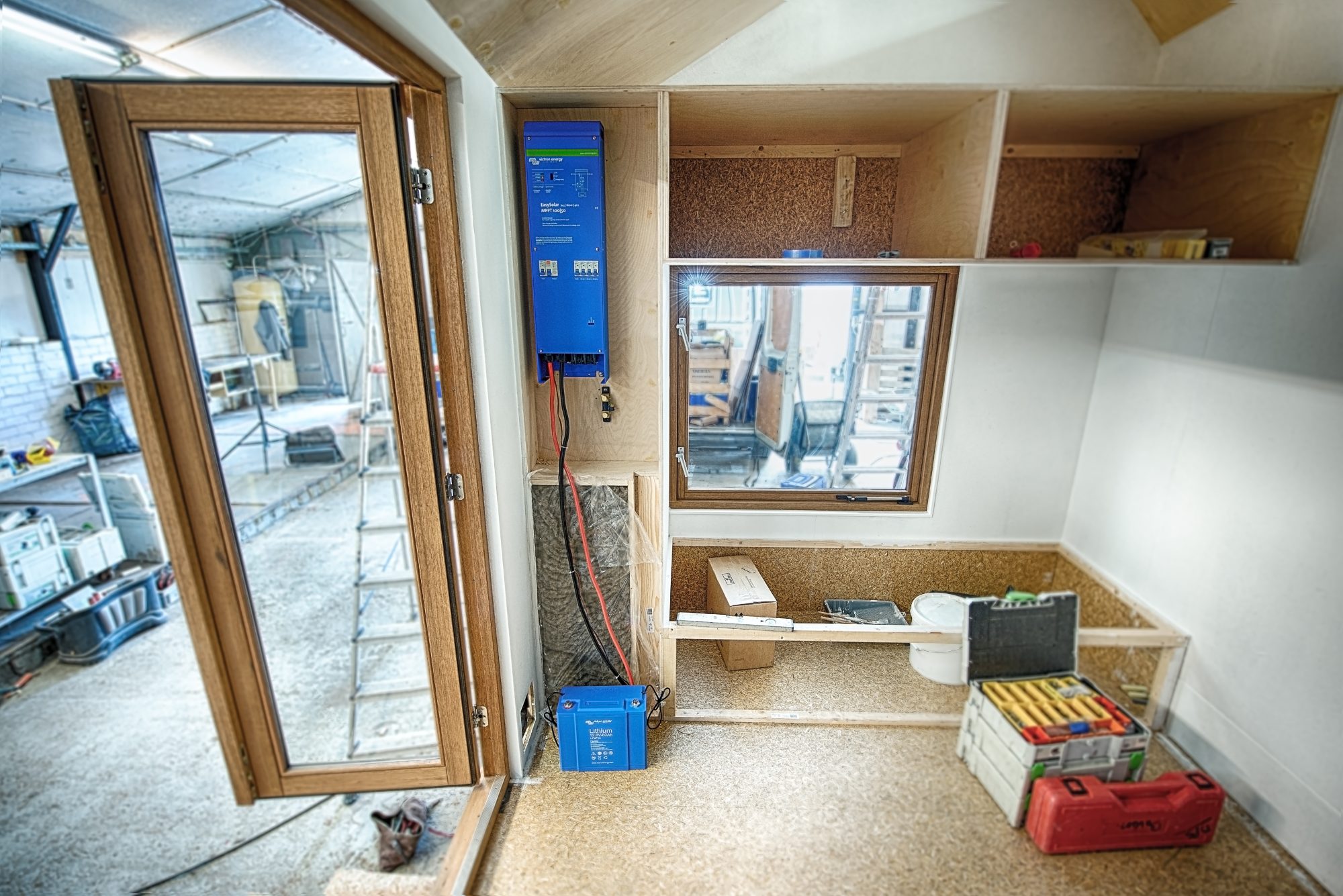I want to be self-sufficient – also known as ‘off-grid’ – with regard to electricity in my Tiny House. But that is not so easy in the Netherlands, because in winter you only have a limited amount of sunlight. According to the KNMI, on average, December has only 2 hours of sunshine per day. Therefore, it’s important to adapt your power consumption and lifestyle to the rhythm of the seasons. In addition, you have to make choices regarding the appliances you want to use: my Tiny House will not have a washing machine but will have a fridge with freezer. It’s about choosing priorities. To calculate how much energy I need, I have listed all the devices I want to use in my home.
- Fridge-freezer combi (109 kwh per year)
- Laptop
- Led lighting
- Small kitchen appliances: blender, juicer, crockpot, hand mixer
- Toilet fan
Based on this data, we calculated that with 3 PV panels of 300 Wp I should have enough power, but from mid-October to February it will be tight. In the summer I will have more than enough electricity, and in winter I will have to be frugal. I will probably need an emergency generator for the dark winter months and I can always buy a windmill in the near future if necessary.

But the 3 PV panels are not all you need. You also have to store that power somewhere during the day. So, you need batteries. In addition, there should be a battery charger as well as an inverter so that the appliances can run at 220 V , AC distribution, and a solar-charging controller. You can buy all of these separately and connect them, but a better solution is the EasySolar of Victron Energy where 3 of these features are combined in one device. Dimka recommended this wonderful system: there are fewer cables, the equipment is perfectly synchronized and therefore there is less chance of error. I contacted Johannes Boonstra of Victron Energy and he was very excited about my project and prepared to help me. The result is that my Tiny House is equipped with a state-of-the-art PV installation including the best batteries I could wish for. My installation set consists of:
- 3 x 300Wp DPS solar panels full black 195.5 x 99.5 cm
- 1 x Easy Solar 24V: an MPPT solar charging controller
- An inverter/charger and ALTERNATING current distribution in one
- 2 x LiFePO4 Lithium batteries 12.8V
I also have a battery monitor, a Color Control monitor and a Wi-Fi receiver, so I can even check my power consumption when I’m not at home. What a luxury! But it is a necessary luxury. By adjusting my behavior, I can make it with solar energy only, and by checking my consumption I will be more aware of the consequences of my actions. My goal is to manage with just the solar power and not use the generator. The installation was carried out by Frans from De PittenSpecialist (DPS) in collaboration with Victron Energy. Frans has years of experience with this type of installation and also loves Tiny houses. I feel so blessed with the help that Johannes and Frans provided!

I’ve already explained why I chose the EasySolar instead of single devices: it works better and you have less chance that something will break. I’m not technically minded and I prefer to have as few cables as possible. I just want a neat installation please. That’s why the EasySolar is the ideal solution for a complete system. Johannes knows how to explain this better. I asked him for some help in writing this article: ‘It is an inverter for everyday consumers, but is also a charger from AC (mains voltage). In addition, there is a group distribution that makes the system secure and keeps the installation costs low. The PV panels can also be connected to the unit. The so-called MPPT charge controller is extremely efficient and pulls up to 30% more out of the PV panels than with a regular controller. More information can be found here.
And now the batteries. My first choice was to opt for an AGM battery, which is cheaper than lithium. However, it has serious drawbacks compared to the latter. Lead batteries are less suitable for PV installations because they charge slowly (5-8 hours), have a fast discharge which reduces capacity (they don’t like to be half empty), and also lose a lot of heat. Lithium batteries, on the other hand, charge very quickly (1 hour), have a constantly available power supply and no heat loss. A lithium battery also lasts much longer so in the long run it is the best choice. Read more about the choice of lithium batteries here.

The PV panels are supplied by Frans of DPS and are also my roofing tiles. We could have chosen 4 smaller panels, but we chose this size because they fit the design of the roof. They are PV panels with a completely black edge and look so good on the roof, where they lie slightly sunken. Frans installed the panels and the Victron Energy installation last Tuesday. Johannes took care of the configuration and Marianka has taken the beautiful pictures and the video you can see in this article.
Thank you very much, Frans, Johannes, and Marianka, for all the effort, information, enthusiasm and help! It gives me great joy that I’m going to live sustainably with solar energy!

Leave a Reply